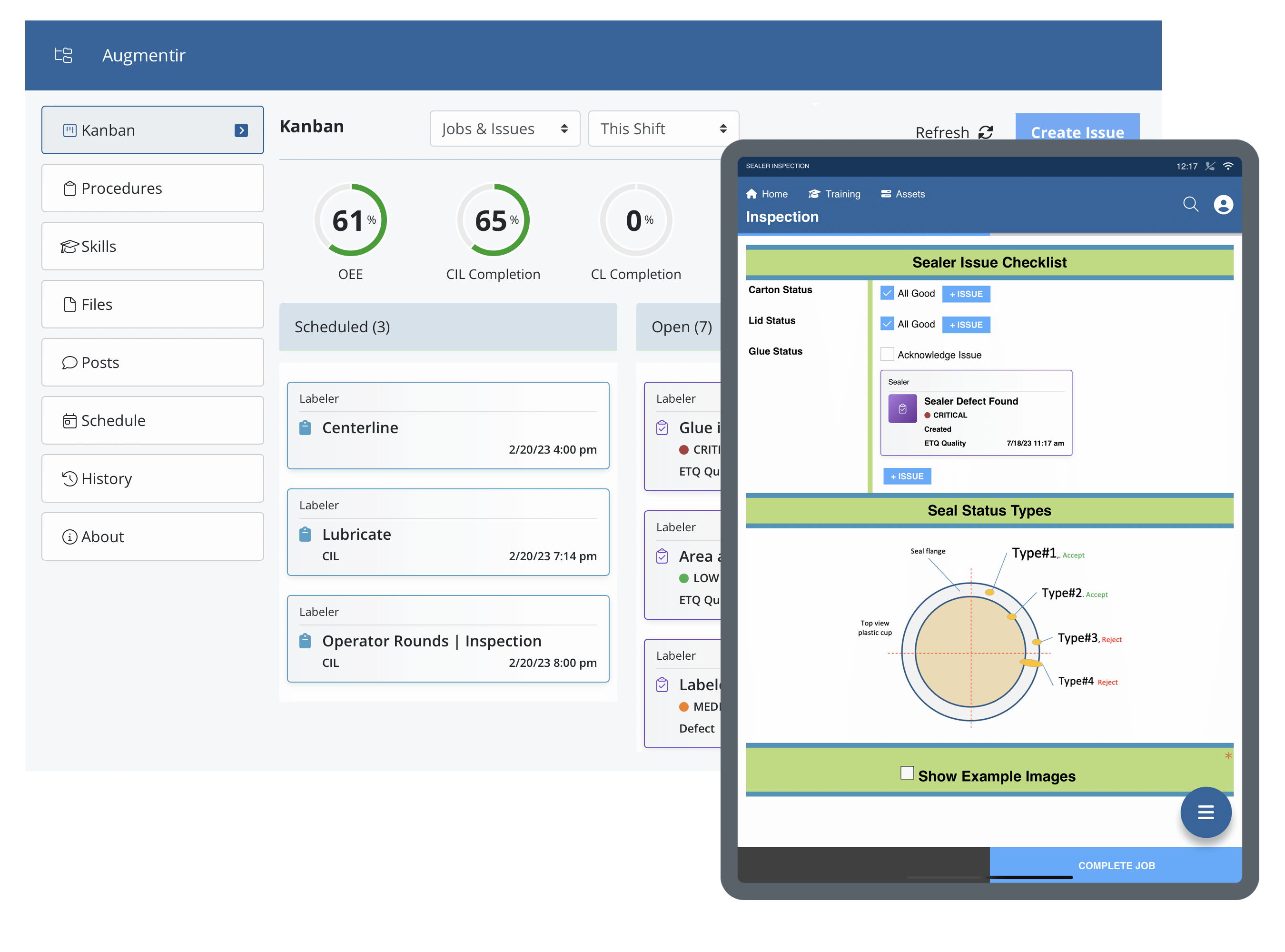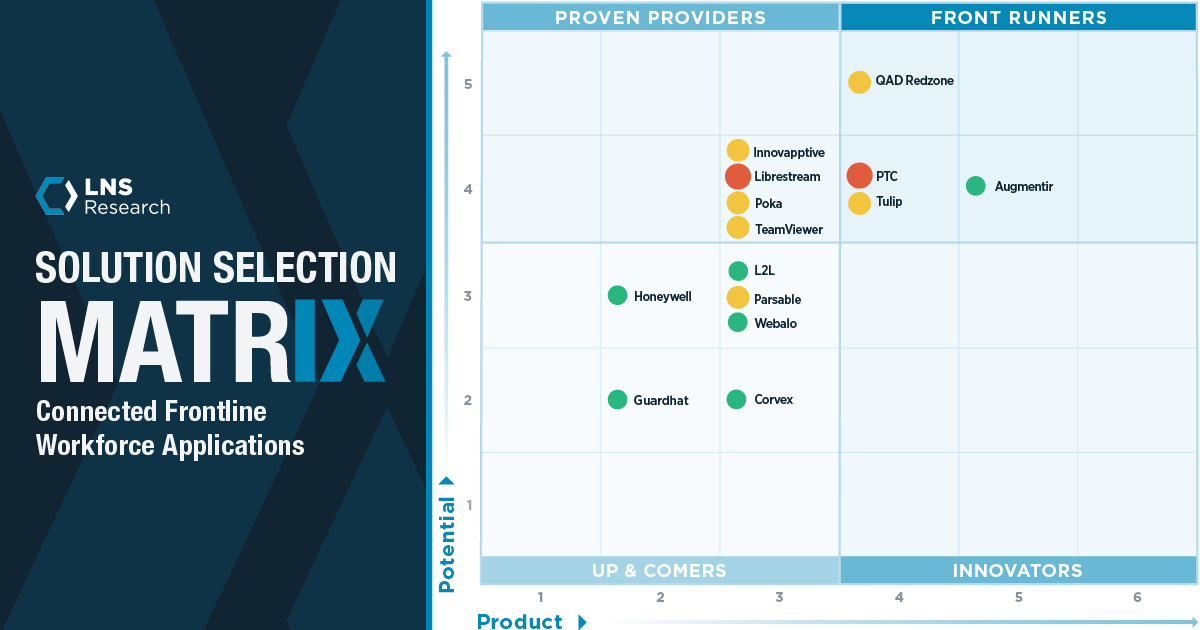Learn how to improve quality control and assurance in the food industry with digital solutions from Augmentir.
Following quality control (QC) and quality assurance procedures in the food industry is imperative to ensure product quality and consumer satisfaction. Today’s consumers demand safe, reliable goods that meet all quality inspection protocols. The last thing you want is for a product to get recalled because of potential health concerns.
According to Food Manufacturing, quality control is one of the most important aspects of the food and beverage industry. Manufacturers who perform routine inspections of products during each stage of the production process significantly increase their chances of delivering items that are free of health hazards and liabilities. But beyond avoiding these concerns, standardizing and digitizing quality procedures benefits the entire operation.
Ultimately, preventing and catching quality issues can boost product quality, reduce waste, raise profits, increase brand reputation, and avoid media or food safety disasters. Learn more about QC and assurance in the food industry and how to improve it as we discuss:
- Types of quality control measures to take
- How to improve QC and assurance procedures in food production
- How Augmentir helps with quality control and assurance

Types of quality control measures to take
There are certain QC measures you can take to ensure that all goods meet quality standards, from regular machine inspections to worker training. They fall into two general categories: preventative and reactive.
Preventative (proactive) quality control: Minimizing the number of deficiencies begins with implementing preventative QC solutions. When workers can catch mistakes before they even happen, they prevent product defects. Preventative QC measures should be practiced on a routine basis and can range from inspecting machines and equipment to offering employee training opportunities. By providing workers with real-time information and guidance through mobile, connected worker solutions, manufacturers enable them to make better decisions about product quality, reducing the risk of errors and identifying potential quality issues before products are shipped to customers, reducing the risk of product recalls, and preserving consumer trust.
Reactive quality control: Catching every defect on the production floor is nearly impossible, even if the most fool-proof strategies are taken. That’s why creating a plan of action ahead of a crisis can help solve quality issues as they happen.
What to put in your plan will depend on the potential problems. For example, you can include specific instructions on what to do if machinery breaks down or stops unexpectedly. It’s vital to collect any data at this stage. Analyzing this data can help you improve preventative quality control in the future to make sure the same problems don’t happen again.
By utilizing AI and modern, digital technologies, companies can connect, engage, and empower frontline workers to drive quality improvements, resolve quality issues faster, and share timely insights with teams across the value chain.
Keep in mind that practicing quality control in the food industry should be part of every manufacturing process, from product ideation and development to production and delivery. Problems can develop at any time, so it’s crucial to follow protocols at every stage of production to prevent even the slightest of mistakes.
All workers should also uphold QC and assurance protocols in their everyday tasks to ensure continuous product improvement.
Better organization of equipment can also help workers understand how the action of one affects the other to solve any potential problems. This is another benefit of integrating your asset hierarchy with a connected worker solution. In a nutshell, strong hierarchies are a solid foundation for proper maintenance management and reliability.
How to improve QC and assurance procedures in food production
Effective quality control and assurance procedures prevent defective food products from making their way into grocery stores and homes. That’s why manufacturers should document the quality of their goods at every stage of the operational process. Strategies like first time quality (FTQ), or first time right, plans coupled with smart, connected solutions help decrease product deficiencies and increase customer satisfaction.
Manufacturing firms in the food industry must follow specific requirements set by the Food and Drug Administration (FDA), Good Manufacturing Practices (GMP) system, and the Hazard Analysis and Critical Control Points (HACCP). The guidelines set by these regulatory bodies can give businesses a better idea of how their processes should look and what data they need to collect and report.
Data should be collected for real-time production processes. These vary by product but may range from product chilling and thermal processing to testing raw materials for metal toxins and other chemical deposits.
The following steps provide a roadmap for how to improve quality control in the food industry.
Step 1: Source the correct ingredients
A successful assembly line run begins with finding and using the correct ingredients. Some things to think about when deciding which ingredients to choose: where the raw material was sourced, when, and its condition.
Step 2: Include an approved supplier list
Make sure that each ingredient has an approved supplier list. A good rule of thumb is to include three vendors per ingredient and record the ingredient with each supplier’s name, address, and code number on the list. The more information you include, the better. Having an approved vendor list ensures that all parties are properly vetted by the manufacturing firm and meet its requirements for quality and distribution.
Step 3: Document product and recipe creation
Documenting how each food item is made and its recipe helps set the quality standards for finished goods. This documentation can also be useful when improving product development in the future. Your document should include the types of ingredients used, their codes, batch yield, percentage formula, and more.
Step 4: Catalog production procedures
It’s also critical to log all the details of a production process, including how materials should be delivered, the appropriate conditions for storing food, what order each ingredient should be added to the batch, what tools are needed, and who is in charge of each task.
Note that this step is different from documenting product and recipe development because it includes the actual instructions for carrying out each procedure. For example, a worker may be asked to preheat the oven to a certain temperature as part of ensuring the food is ready for customer distribution.
Step 4: Record real-time processes
Machine operators should record in real-time every detail of how goods are created during actual production. This can include factors like product size, weight, expiration date, equipment conditions, and more.
Step 5: Digitize assurance and inspection processes
AI and smart, connected worker systems help digitize and link inspections and other quality control procedures. This creates an additional layer of defense, protecting customers and preventing quality issues before they can impact production.
How Augmentir helps with quality control and assurance
Augmentir offers a smarter way to improve quality control in the food industry by effectively standardizing and optimizing quality assurance and inspection procedures for all frontline workers. With our smart, connected solutions coupled with AI-powered software, food manufacturers have improved quality control and assurance by:
- Tracking and analyzing data to identify trends and opportunities for improvements
- Reducing human error in inspections by standardizing and improving training procedures and processes
- Transforming connected workers into human sensors who can proactively address quality and safety events that surface during manufacturing operations

Our AI-powered connected worker solutions, provide digital work instructions to help employees better perform inspection checks and reduce the number of production errors and rework.
These customized solutions also include:
- Digital standard operating procedures (SOPs) for how to complete assembly line tasks. These step-by-step instructions can greatly improve workflow efficiency, increase regulatory compliance, and reduce mistakes on the shop floor.
- Digital workflows that convert your paper-based processes to digital work instructions and personalize them to the needs of each worker.
- Enhanced product traceability to decrease equipment setup time, reduce process inconsistencies, and better meet customer expectations. Our digital instructions help you to easily track materials from the supply chain, inventory, and across every production process.
If you are interested in learning why companies are choosing Augmentir to help improve their quality control and assurance processes, check out our quality use cases – or reach out to schedule a live demo.



